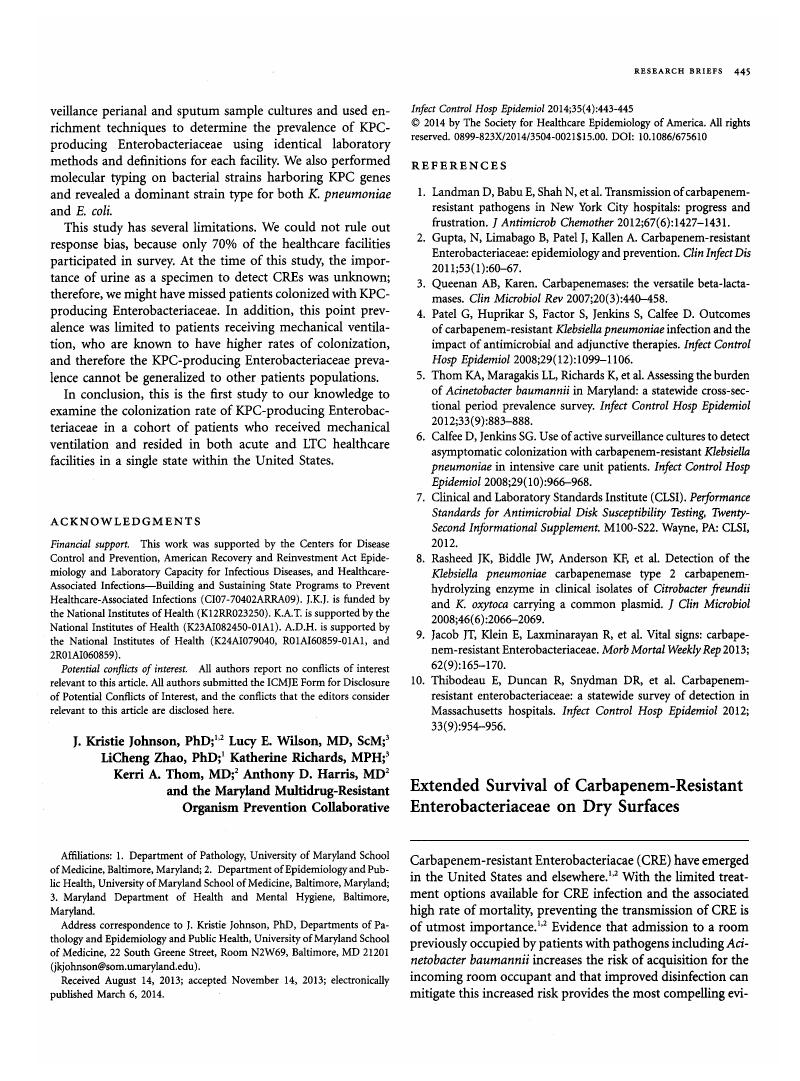Crossref Citations
This article has been cited by the following publications. This list is generated based on data provided by Crossref.
Chemaly, Roy F.
Simmons, Sarah
Dale, Charles
Ghantoji, Shashank S.
Rodriguez, Maria
Gubb, Julie
Stachowiak, Julie
and
Stibich, Mark
2014.
The role of the healthcare environment in the spread of multidrug-resistant organisms: update on current best practices for containment.
Therapeutic Advances in Infectious Disease,
Vol. 2,
Issue. 3-4,
p.
79.
Torres-González, Pedro
Bobadilla-del Valle, Miriam
Tovar-Calderón, Estrella
Leal-Vega, Francisco
Hernández-Cruz, Araceli
Martínez-Gamboa, Areli
Niembro-Ortega, María Dolores
Sifuentes-Osornio, José
and
Ponce-de-León, Alfredo
2015.
Outbreak Caused by Enterobacteriaceae Harboring NDM-1 Metallo-β-Lactamase Carried in an IncFII Plasmid in a Tertiary Care Hospital in Mexico City.
Antimicrobial Agents and Chemotherapy,
Vol. 59,
Issue. 11,
p.
7080.
Weber, David J.
Rutala, William A.
Kanamori, Hajime
Gergen, Maria F.
and
Sickbert-Bennett, Emily E.
2015.
Carbapenem-Resistant Enterobacteriaceae: Frequency of Hospital Room Contamination and Survival on Various Inoculated Surfaces.
Infection Control & Hospital Epidemiology,
Vol. 36,
Issue. 5,
p.
590.
Dramowski, Angela
Whitelaw, Andrew
and
Cotton, Mark F.
2016.
Assessment of terminal cleaning in pediatric isolation rooms: Options for low-resource settings.
American Journal of Infection Control,
Vol. 44,
Issue. 12,
p.
1558.
Goodman, KE
Simner, PJ
Tamma, PD
and
Milstone, AM
2016.
Infection control implications of heterogeneous resistance mechanisms in carbapenem-resistant Enterobacteriaceae (CRE).
Expert Review of Anti-infective Therapy,
Vol. 14,
Issue. 1,
p.
95.
Gostine, Andrew
Gostine, David
Donohue, Cristina
and
Carlstrom, Luke
2016.
Evaluating the effectiveness of ultraviolet-C lamps for reducing keyboard contamination in the intensive care unit: A longitudinal analysis.
American Journal of Infection Control,
Vol. 44,
Issue. 10,
p.
1089.
Wilson, A.P.R.
Livermore, D.M.
Otter, J.A.
Warren, R.E.
Jenks, P.
Enoch, D.A.
Newsholme, W.
Oppenheim, B.
Leanord, A.
McNulty, C.
Tanner, G.
Bennett, S.
Cann, M.
Bostock, J.
Collins, E.
Peckitt, S.
Ritchie, L.
Fry, C.
and
Hawkey, P.
2016.
Prevention and control of multi-drug-resistant Gram-negative bacteria: recommendations from a Joint Working Party.
Journal of Hospital Infection,
Vol. 92,
Issue. ,
p.
S1.
Muzslay, M.
Moore, G.
Alhussaini, N.
and
Wilson, A.P.R.
2017.
ESBL-producing Gram-negative organisms in the healthcare environment as a source of genetic material for resistance in human infections.
Journal of Hospital Infection,
Vol. 95,
Issue. 1,
p.
59.
Moghadampour, Mehdi
Salari-Jazi, Azhar
and
Faghri, Jamshid
2018.
High rate of carbapenem-resistant Klebsiella pneumoniae detected from hospital equipments in Iran.
Acta Microbiologica et Immunologica Hungarica,
Vol. 65,
Issue. 4,
p.
529.
Wakefield, Chris
2019.
Healthier practice is in our hands.
Practice Management,
Vol. 29,
Issue. 3,
p.
36.
Weterings, Veronica
Veenemans, Jacobien
Kleefman, Amanda
den Bergh, Marjolein Kluytmans-van
Mulder, Paul
Verhulst, Carlo
Willemsen, Ina
and
Kluytmans, Jan
2019.
Evaluation of an in vitro model with a novel statistical approach to measure differences in bacterial survival of extended-spectrum β-lactamase-producing Escherichia coli on an inanimate surface.
Antimicrobial Resistance & Infection Control,
Vol. 8,
Issue. 1,
Weber, David J.
Sickbert-Bennett, Emily E.
Kanamori, Hajime
and
Rutala, William A.
2019.
New and emerging infectious diseases (Ebola, Middle Eastern respiratory syndrome coronavirus, carbapenem-resistant Enterobacteriaceae, Candida auris): Focus on environmental survival and germicide susceptibility.
American Journal of Infection Control,
Vol. 47,
Issue. ,
p.
A29.
Shimoda, Tomoko
Okubo, Torahiko
Enoeda, Yoshiki
Yano, Rika
Nakamura, Shinji
Thapa, Jeewan
Yamaguchi, Hiroyuki
and
Byrd, Thomas
2019.
Effect of thermal control of dry fomites on regulating the survival of human pathogenic bacteria responsible for nosocomial infections.
PLOS ONE,
Vol. 14,
Issue. 12,
p.
e0226952.
Zhou, Kai
Xiao, Tingting
David, Sophia
Wang, Qin
Zhou, Yanzi
Guo, Lihua
Aanensen, David
Holt, Kathryn E.
Thomson, Nicholas R.
Grundmann, Hajo
Shen, Ping
and
Xiao, Yonghong
2020.
Novel Subclone of Carbapenem-Resistant Klebsiella pneumoniae Sequence Type 11 with Enhanced Virulence and Transmissibility, China.
Emerging Infectious Diseases,
Vol. 26,
Issue. 2,
p.
289.
Lemarié, C.
Legeay, C.
Lasocki, S.
Mahieu, R.
Kouatchet, A.
Bahier, L.
Onillon, L.
Corre, M.
Kempf, M.
and
Eveillard, M.
2020.
Extended-spectrum β-lactamase Enterobacteriaceae (ESBLE) in intensive care units: strong correlation with the ESBLE colonization pressure in patients but not same species.
Journal of Hospital Infection,
Vol. 104,
Issue. 1,
p.
53.
Hilliquin, D.
Lomont, A.
and
Zahar, J-R.
2020.
Cohorting for preventing the nosocomial spread of carbapenemase-producing Enterobacterales in non-epidemic settings: should it be mandatory?.
Journal of Hospital Infection,
Vol. 105,
Issue. 3,
p.
534.
Rose, Laura J.
Houston, Hollis
Martinez-Smith, Marla
Lyons, Amanda K.
Whitworth, Carrie
Reddy, Sujan C.
Noble-Wang, Judith
and
Moore, Ginny
2022.
Factors influencing environmental sampling recovery of healthcare pathogens from non-porous surfaces with cellulose sponges.
PLOS ONE,
Vol. 17,
Issue. 1,
p.
e0261588.
Liu, Ying
Zhu, Shichao
Wei, Li
Feng, Yu
Cai, Lin
Dunn, Steven
McNally, Alan
and
Zong, Zhiyong
2022.
Arm race among closely-related carbapenem-resistant Klebsiella pneumoniae clones.
ISME Communications,
Vol. 2,
Issue. 1,
Ugoala, Emeka
2023.
Antibacterial Resistant Pathogens Potential Reservoirs.
Current Research in Bacteriology,
Vol. 16,
Issue. 1,
p.
1.
Gu, G.Y.
Chen, M.
Pan, J.C.
and
Xiong, X.L.
2023.
Risk of multi-drug-resistant organism acquisition from prior bed occupants in the intensive care unit: a meta-analysis.
Journal of Hospital Infection,
Vol. 139,
Issue. ,
p.
44.



